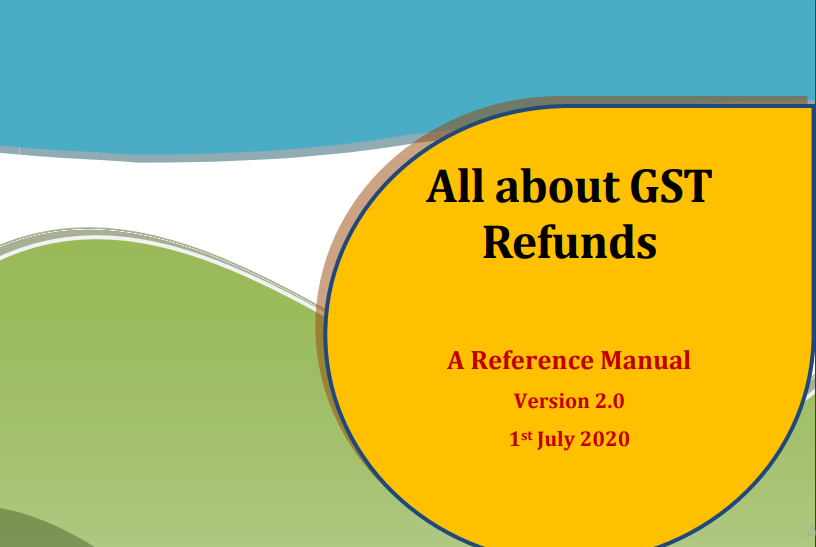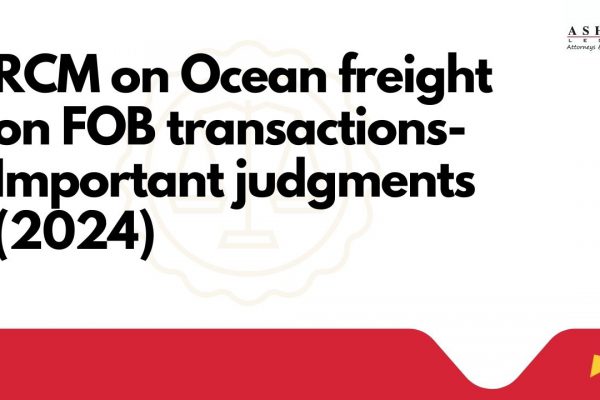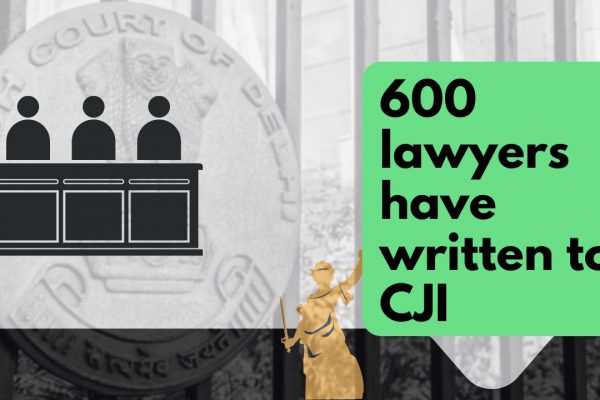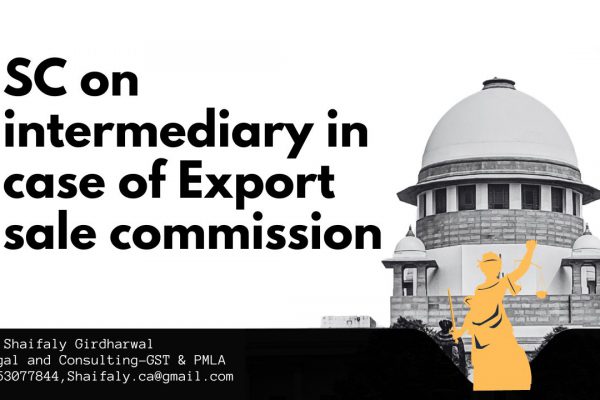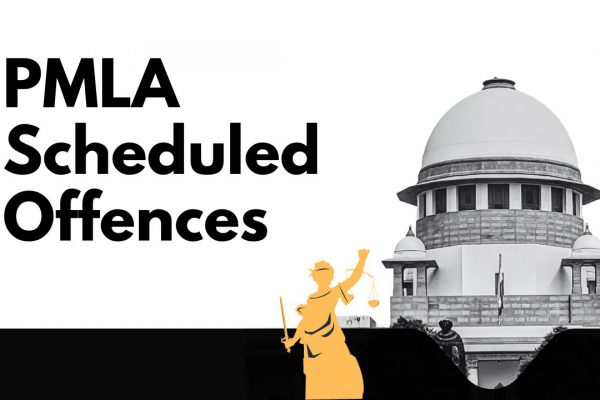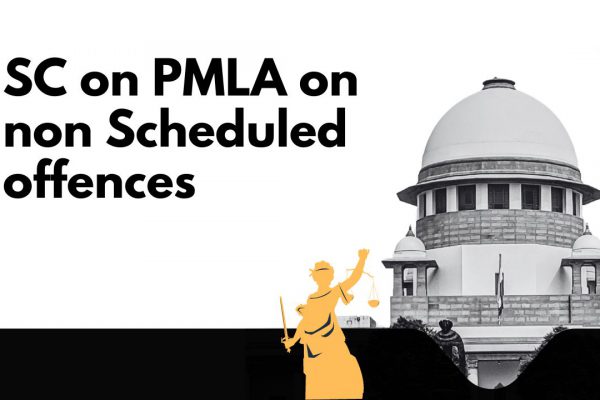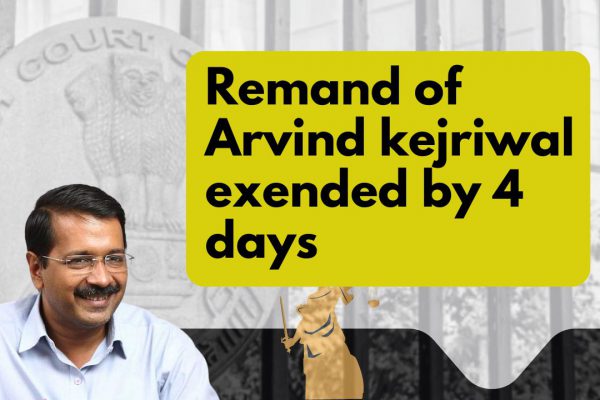Reference Material on GST Refunds by CBIC
Introduction
Goods and Services Tax (GST) in India, is a form of a Value–Added Tax (VAT). The overarching purpose of GST was to impose a broad-based tax on Consumption. It is a destination-based consumption tax.
The existing taxes before GST operated under the origin principle – the jurisdiction where the taxable activity took place levied and collected the tax. Origin based taxation created a scope at the sub-national level for a State to either export taxes onto other states or to undermine the companion State’s tax base by undercutting the tax rates charged elsewhere. Levying VAT on an origin basis, as it was happening in VAT before GST meant that taxes were being charged on the value that was added to a product in a different jurisdiction, at the rates charged by those jurisdictions which could well have been different from the rates in the destination states. The Firms producing in multiple jurisdictions then had an incentive to transfer price value-added into low tax jurisdictions, for instance by charging high internal prices for intra-firm sales out of them.
The change in GST to the destination principle places all firms competing in a given jurisdiction on an even footing. Thus, the tax paid on any taxable supply made under GST is determined by a set of rules to decide where this tax revenue will be destined to. These ground rules are contained in Sections 8 through 14 of the Integrated Goods and Services Tax (IGST) Act, 2017 that determine the nature and the place of consumption for every transaction of ‘supply’. All revenues in GST accrue to the jurisdiction where the supply is said to be consumed. There is a widespread consensus now that the destination principle, with revenue accruing to the country (and at a sub-national level – to the State/UT) where the final consumption occurs, is preferable to the origin principle from both a theoretical and practical standpoint.
The GST has unified the tax base at the Federal and the sub-national level in the Indian context. This has happened through uniformity of laws, tax rates, and the adoption of a single taxable event across both national and subnational levels. The taxable event in Indian GST is that of ‘supply’ which is more broad-based than any single taxable event like manufacture or sale, in the taxes that it replaced. In GST, we have managed to achieve compliance symmetry (Identical compliance requirement for inter- and intra-provincial traders) – it was desirable to have such a compliance symmetry to have significant cost savings and efficiency at the firm level and thereby, at an aggregate level for the nation.
In general, the GST is imposed at every stage of the economic process and a deduction of taxes on purchases is allowed by all but the final consumer. The mechanism of input tax credits through the supply chain, except by the final consumer, ensures the neutrality of the tax, whatever the nature of the product, the structure of the distribution chain, and the means used for its delivery (e.g. retail stores, physical delivery, Internet downloads). There is a clear mechanism in place that allows for a credit of the tax levied on transactions between businesses. The system is based on tax collection in a staged process, with successive businesses entitled to deduct input tax on “capital goods”, “inputs” or “input services” and account for a tax on “outward supplies”. As a result of the staged payment system, GST thereby “flows through the businesses” to tax supplies made to final consumers. Following the destination principle, in GST exports are not subject to tax with a refund of input taxes (that is “zero-rated”) being made available, but imports are taxed (through the impost of an Integrated Goods and Services Tax -IGST) on the same basis and at the same rates as domestic supplies. These features give GST one of its main characteristics, that of neutrality.
This destination principle is sanctioned by the World Trade Organization (WTO) rules. In the predecessor GATT System that existed before the WTO, addenda to Article XVI of the 1947 General Agreement on Trade and Tariffs (GATT) excluded explicitly that such an exemption could be considered a subsidy: The exemption of an exported product from duties or taxes borne by the like product when destined for domestic consumption or the remission of such duties or taxes in amounts not over those which have accrued were not deemed to be a subsidy. Consequently, Article 6.4 of the 1947 General Agreement stipulated that: No product of the territory of any contracting party imported into the territory of any other contracting party shall be subject to … countervailing duty by reason of [such exemptions or refunds]. This principle was not changed within the framework of the WTO system, since Article I of the Uruguay Round Subsidies Agreement, which defines a subsidy, stipulates once again in footnote 1 that: the exemption of an exported product from duties or taxes borne by the like product when destined for domestic consumption or the remission of such duties or taxes in amounts not in excess of those which have accrued, shall not be deemed to be a subsidy1.
In GST law, the Integrated Goods and Service Tax (IGST) Act, 2017, in Chapter VII deals with the ZERO RATED SUPPLY. Section 16 of the IGST Act defines a “zero-rated supply” to mean any of the following supplies of goods or services or both, namely:-
(a) Export of goods or services or both; or
(b) Supply of goods or services or both to a Special Economic Zone developer or a Special Economic Zone unit.
The credit of input tax can also be availed for making zero-rated supplies subject to the provisions of sub-section (5) of section 17 of the Central Goods and Services Tax Act, 2017 (CGST Act). Under the provisions of section 54 of the Central Goods and Services Tax Act any person registered under GST and making zero-rated supply is eligible to claim a refund under either of the following options: –
(a) He may supply goods or services or both under bond or Letter of Undertaking, without payment of integrated tax and claim refund of the unutilized input tax credit; or
(b) He may supply goods or services or both, on payment of integrated tax and claim a refund of such tax paid on goods or services or both supplied.
More generally, the following kinds of Refunds are available to eligible taxpayers under GST:
i. A refund of tax paid on zero-rated supplies of goods or services or both or on inputs or input services used in making such zero-rated supplies,
ii. A Refund of tax on the supply of goods regarded as deemed exports,
iii. A refund of the unutilized input tax credit.
‘Supply’ in GST
In GST, the taxable event is the event of a “Supply”. In ordinary language, supply means make (something needed or wanted) available to someone; to provide. Supply could be an interstate supply or an intrastate one.
The GST is levied in the form of a Central Goods and Services Tax (CGST) and a State or Union Territory Goods and Services Tax (SGST or UTGST) on all intra-State supplies of goods or services or both, except on the supply of alcoholic liquor for human consumption. The value taken for the charge of the tax is determined under Section 15 of the CGST Act and the tax is calculated at such rates, not exceeding twenty percent, as may be notified by the Government on the recommendations of the Council. An Integrated Goods and Services Tax (IGST) is levied instead of a Central Goods and Services Tax and a State or Union Territory Goods and Services Tax whenever the supply happens to be an interstate one.
In terms of Section 7 of the CGST Act that deals with the “Scope of Supply’, “supply” includes all forms of supply of goods or services or both such as sale, transfer, barter, exchange, license, rental, lease or disposal made or agreed to be made for a consideration by a person in the course or furtherance of business. Thus, the general tests for a transaction to be reckoned as a supply or not are two – the first being the Business Test (whether the supply is made in the course or furtherance of business) AND the Second is the Test of the Consideration for the particular supply concerned in the transaction that may have been made or agreed to be made. However, in GST law, the Business Test mentioned above does not apply to the situation of import of services for a consideration. Any Import of Services thus become liable to tax whether or not made in the course or furtherance of business. Besides, there is a set of activities specified in Schedule I to the CGST Act, made or agreed to be made without any consideration, that if engaged in have to be construed as being an instance of a ‘supply’.
Schedule II to the CGST Act contains a listing of activities or transactions that constitute a supply in the sense of the meaning assigned to the expression but are to be treated either as a supply of goods or supply of services to ease the matters relating to the determination of the place of supply and matters relating to the rate of tax attracted on the particular transactions.
Furthermore, Activities or transactions specified in Schedule III to the CGST Act; or such activities or transactions undertaken by the Central Government, a State Government or any local authority in which they are engaged as public authorities, as may be notified by the Government on the recommendations of the Council are to be treated neither as a supply of goods nor a supply of services.
Input Tax Credits in GST
Chapter V of the CGST Act deals with Input Tax Credit (ITC).
Section 16 of the CGST Act entitles every registered person to take credit of input tax charged on any supply (of goods or services or both) to him which are used or intended to be used in the course or furtherance of his business.
Credit is permitted to be taken on ‘capital goods’, ‘inputs’, and on ‘input services’. The entitlement to credit is subject to certain prescribed conditions and restrictions. The ITC is made available to the registered person as a credit in his electronic credit ledger. To take credit, the registered person should have a tax invoice or debit note (or any other prescribed taxpaying documents) issued by a GST registered supplier and he should also have received the goods or services or both on which the ITC is sought to be taken. Section 49 of the CGST Act deals with how the input tax credit is credited to the electronic credit ledger of the registered taxpayer.
The CGST law – Section 16 (2) (c) & (d) also entails that before the ITC is taken by the Recipient of either goods or services or both, the tax charged in respect of such input supplies should have been actually paid to the Government, either in cash or through the utilization of input tax credit admissible in respect of the such a supply; and that the supplier making the input supplies furnish the return under section 39.
In terms of the 1st, and 2nd Provisos to Section 16(2)(c) of the CGST Act, where the goods against an invoice are received in lots or installments, the registered person is entitled to take credit upon receipt of the last lot or installment. Besides, it is also stipulated that the recipient of input supplies (either goods or services or both) should pay the amount towards the value of supply along with tax payable thereon within a period of one hundred and eighty days from the date of issue of invoice by the supplier of goods or services or both, other than the supplies on which tax is payable on reverse charge basis- in case, the stipulated payments are not made in this time of 180 days an amount equal to the input tax credit availed by the recipient would be added to his output tax liability of the recipient, along with interest thereon.
The 3rd Proviso to Section 16(2) (c) of the CGST Act deals with the reverse charge situations and provides that the recipient of goods and services or both, is entitled to avail of the credit of input tax on payment made by him of the amount towards the value of supply of goods or services or both along with tax payable thereon.
Section 16 (3) of the CGST Act disallows the registered person from claiming input tax credit on the tax component of the cost of capital goods and plant and machinery that has been claimed as depreciation on under the provisions of the Income-tax Act, 1961 (43 of 1961). Section 16 (4) permits input tax credit in respect of any invoice or debit note for the supply of goods or services or both but puts a timeline within which such a credit can be taken.
The amount of input tax credit is restricted to so much of the input tax as is attributable to the purposes of his business – in cases where the goods or services or both are used by the registered person partly for any business and partly for other purposes [Section 17(1) of the CGST Act] – this is a practice consistent with the laws and practices in many other tax jurisdictions outside India which follow GST/ VAT models. In cases where the goods or services or both are used by the registered person partly for effecting taxable supplies including zero-rated supplies and partly for effecting exempt supplies under the said Acts, the amount of credit is restricted to the input tax as can be attributed to the said taxable supplies including zero-rated supplies [Section 17(2) of the CGST Act]. The value of exempt supply can be worked out using [Section 17(3) of the CGST Act]. Section 17(4) of the CGST Act gives two options on the manner of taking ITC, either one of which may be exercised, to a banking company or a financial institution including a non-banking financial company, engaged in supplying services by way of accepting deposits, extending loans or advances.
Section 17 (5) restricts the input tax credit from being available in respect of certain input supplies – like on certain classes of motor vehicles, vessels, and aircraft, on food and beverages, outdoor catering, beauty treatment, health services, cosmetic and plastic surgery, life insurance, etc. However, some of these exclusions are not absolute and there are specific situations in which ITC can be taken on some such supplies.
Section 18 of the CGST Act makes input tax credit available in respect of inputs and capital goods sent for a job-work, subject to observance of stipulated conditions.
Section 20 of the CGST Act deals with the manner of distribution of credit by an “Input Service Distributor”.
The framework of the input tax credit mechanism outlined above applies to all three taxes in GST – the central tax, the integrated tax, and the State Tax.
Exports in GST
In terms of Section 2 (5) of the IGST Act, “export of goods” with its grammatical variations and cognate expressions, means taking goods out of India to a place outside India. An “export of services” in terms of Section 2(6) of the IGST Act means the supply of any service when, –
(i) The supplier of service is located in India;
(ii) The recipient of service is located outside India
(iii) The place of supply of service is outside India
(iv) The payment for such service has been received by the supplier of service in convertible foreign exchange [or in Indian rupees wherever permitted by the Reserve Bank of India]; and
(v) The supplier of service and the recipient of service are not merely establishments of a distinct person
In GST certain establishments are treated as establishments of distinct persons where a person has –
(i) An establishment in India and any other establishment outside India;
(ii) An establishment in a State or Union territory and any other establishment outside that State or Union territory; or
(iii) An establishment in a State or Union territory and any other establishment registered within that State or Union territory.
The location of the supplier of service, the location of the recipient of service, and the place of supply of service are determinable in terms of Sections 2(15) and Section 2(14) of the IGST Act. In cases where the location of the supplier or location of the recipient is outside India, the place of supply of the concerned service can be determined with reference to provisions of Section 13 of the IGST Act.
Zero‐rated supplies under GST
Export of goods or services or both, and the supply of goods or services or both, to a Special Economic Zone developer or a Special Economic Zone unit – are zero-rated as per Section 16(1)(a) & (b) respectively of the IGST Act, 2017.
By zero-rating it is meant that the tax impact on the entire supply chain leading up to the particular transaction that is being ‘Zero Rated” is made tax free i.e. there is no burden of tax to be borne either on the inputs leading up to the particular outward supply or on the outward supply itself. [In terms of Section 2 (83) of the CGST Act 2017, “outward supply” in relation to a taxable person, means a supply of goods or services or both, whether by sale, transfer, barter, exchange, license, rental, lease or disposal or any other mode, made or agreed to be made by such person in the course or furtherance of business.]
Zero-rating in GST implies the following: –
i. The credit of input tax may be availed for making zero-rated supplies; notwithstanding that such supply may be an exempt supply (note: credit eligibility still needs to be checked with reference to terms of provisions of Chapter V of the CGST Act, 2017).
ii. A registered person making zero rated supply shall be eligible to claim refund in accordance with the provisions of section 54 of the CGST Act under either of the following options, namely :-
(a) he may supply goods or services or both under bond or Letter of Undertaking, without payment of integrated tax and claim refund of the unutilised input tax credit; or
(b) he may supply goods or services or both, on payment of integrated tax and claim refund of such tax paid on goods or services or both supplied.
The Zero- Rated situations can be contrasted with the other situation where a particular supply under the GST has been exempted from the charge of the tax – in the latter situation, it is only that the outward supply or the output that is exempted from tax, but the tax borne on all the inputs that may have gone into making this outward supply is not refunded. The essence of zero-rating is thus, to make Indian goods and services competitive in the international market by ensuring that domestic taxes do not get added as a cost in exports.
The objective of zero-rating of exports and supplies to SEZ/SEZ Developer is achieved through the provision contained in Section 16(3) of the IGST Act, 2017.
Refund in GST
When tax, interest, or any other amount is paid to the Government more than the liability incurred or accrued, then a refund situation arises. In terms of the explanation to Section 54 of the CGST Act, “refund” includes a refund of tax paid on zero-rated supplies of goods or services or both or on inputs or input services used in making such zero-rated supplies, or refund of tax on the supply of goods regarded as deemed exports, or refund of the unutilized input tax credit.
Statutory provisions relating to refunds in GST
Chapter XI of the CGST Act, 2017, in Sections 54 to 56 deals with refunds under GST. The procedure for claiming refunds is contained in Chapter X of the CGST Rules, 2017 under Rules 89 to 97A.
Read & Download the full copy in pdf:
If you already have a premium membership, Sign In.
 ConsultEase Administrator
ConsultEase Administrator
Consultant
Faridabad, India
As a Consultease Administrator, I'm responsible for the smooth administration of our portal. Reach out to me in case you need help.


